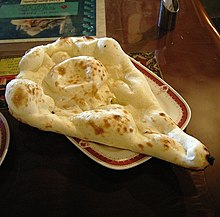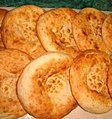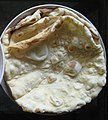
Roti is a round flatbread native to the Indian subcontinent. It is commonly consumed in many South Asian, Southeast Asian, Caribbean, and Southeast African countries.

Pakistani cuisine can be characterized as a blend of regional cooking styles and flavours from across South, Central and Western Asia. Pakistani cuisine is influenced by Persian, Indian, and Arab cuisine. The cuisine of Pakistan also maintains certain Mughal influences within its recipes and cooking techniques. Pakistan's ethnic and cultural diversity, diverse climates, geographical environments, and availability of different produce lead to diverse regional cuisines.

Punjabi cuisine is a culinary style originating in the Punjab, a region in the northern part of South Asia, which is now divided in an Indian part to the east and a Pakistani part to the west. This cuisine has a rich tradition of many distinct and local ways of cooking.

Lavash is a thin flatbread usually leavened, traditionally baked in a tandoor or on a sajj, and common to the cuisines of South Caucasus, West Asia, and the areas surrounding the Caspian Sea. Lavash is one of the most widespread types of bread in Armenia, Azerbaijan, Iran and Turkey. The traditional recipe can be adapted to the modern kitchen by using a griddle or wok instead of the tonir.

Barbari bread is a type of yeast leavened flatbread. It is one of the thickest flat breads and is commonly topped with sesame or black caraway seeds. A notable characteristic of the bread is its top skin that is similar to pretzels or lye roll's skin due to the Maillard reaction that occurs during baking. Before baking it is glazed with a mixture of baking soda, flour and water. It is widely known as Persian flatbread in United States and Canada.

A flatbread is bread made usually with flour; water, milk, yogurt, or other liquid; and salt, and then thoroughly rolled into flattened dough. Many flatbreads are unleavened, although some are leavened, such as pita bread.

Indian breads are a wide variety of flatbreads and crêpes which are an integral part of Indian cuisine. Their variation reflects the diversity of Indian culture and food habits.

Taftan or taftoon is a leavened flour bread from Iran, introduced to Kuwaiti and South Asian cuisines. It is made with refined flour, milk, yoghurt, and eggs and baked in a clay oven. It is sometimes flavoured with saffron and a small amount of cardamom powder, and may be decorated with seeds such as poppy seeds.
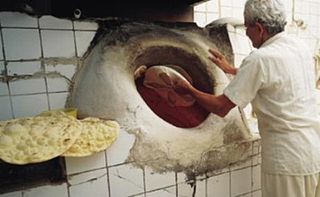
Khubz, alternatively transliterated as khoubz, khobez, khubez, or khubooz, is the usual word for "bread" in Standard Arabic and in many of the vernaculars.

Bakarkhani or Baqarkhani or Bakorkhoni also known as bakarkhani roti, is a thick, spiced flat-bread that is part of the Mughlai cuisine. Bakarkhani is prepared on certain Muslim religious festivals in South Asia and is now popular as sweet bread.
Cuisine of Uttar Pradesh is from the state of Uttar Pradesh (UP) located in Northern India. The cuisine of UP has a large variety of dishes. The cuisine consists of both vegetarian and non-vegetarian dishes of different varieties. Being a large state, the cuisine of UP share lot of dishes and recipes with the neighboring states of Delhi, Uttarakhand, Bihar, Jharkhand and Haryana. Apart from native cuisine, Mughlai, Awadhi and Bhojpuri are famous subtypes of cuisine of the state.
Awadhi cuisine is a cuisine native to the Awadh region in Northern India and Southern Nepal. The cooking patterns of Lucknow are similar to those of Central Asia, the Middle East, and Northern India and western India with the cuisine comprising both vegetarian and non-vegetarian dishes. The Awadh region has been influenced by Mughal cooking techniques, and the cuisine of Lucknow bears similarities to those of Central Asia, Kashmir, Punjab and Hyderabad. The city is also known for its Nawabi foods.

Sheermal, also spelled shirmal, is a saffron-flavored traditional flatbread eaten in Iran and the Indian subcontinent. The word sheermal is derived from the Persian words شیر meaning milk, and مالیدن meaning to rub. In a literal translation, sheermal means milk-rubbed. Found by Persians in Old Dhaka, it was introduced to North India by the Mughal emperors during the medieval period. It became a delicacy of Lucknow, Hyderabad and Aurangabad. It is also part of the Awadhi cuisine and is enjoyed in Old Bhopal and Pakistan.

Tandoor bread refers to a bread baked in a clay oven called a tandoor.

A tandoor is a large urn-shaped oven, usually made of clay. Since antiquity, tandoors have been used to bake unleavened flatbreads, such as roti and naan, as well as to roast meat. The tandoor is predominantly used in Western Asian, Central Asian, South Asian, and Horn of African cuisines.
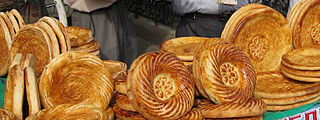
Tandyr nan is a type of Central Asian bread cooked in a vertical clay oven, the tandyr or tandoor. It is circular and leavened with yeast, and typically has a crisp golden surface. They are often decorated by stamping patterns on the dough, and can be topped with ingredients like sesame seeds, nigella seeds, or thinly sliced onion.

Muhajir cuisine refers to the food and culinary style of the Muhajir people in Pakistan, the descendants of Muslim migrants from India who migrated to Pakistan following the partition of India. Most Muhajirs have traditionally been based in Karachi, hence the city being known for Muhajir tastes in its cuisine. This cuisine has a rich tradition of many distinct and local ways of cooking. Muhajirs clung to their old established habits and tastes, including a numberless variety of dishes and beverages.

Paratha is a flatbread native to the Indian subcontinent, with earliest reference mentioned in early medieval Sanskrit, India; prevalent throughout the modern-day nations of India, Pakistan, Nepal, Bangladesh, Maldives, Afghanistan, Myanmar, Malaysia, Singapore, Thailand, Mauritius, Fiji, Guyana, Suriname, and Trinidad and Tobago where wheat is the traditional staple. It is one of the most popular flatbreads in the Indian subcontinent and the Middle East. Paratha is an amalgamation of the words parat and atta, which literally means layers of cooked dough. Alternative spellings and names include parantha, parauntha, prontha, parontay, paronthi (Punjabi), porota, paratha, palata, porotha, forota, farata, prata, paratha, buss-up shut, oil roti and roti canai in Malaysia and Indonesia.

Arab Indonesian cuisine is characterized by the mixture of Middle Eastern cuisine with local Indonesian-style. Arab Indonesians brought their legacy of Arab cuisine—originally from Hadhramaut, Hejaz, Sudan and Egypt—and modified some of the dishes with the addition of Indonesian ingredients. The Arabs arrived in the Nusantara archipelago to trade and spread Islam. In Java, since the 18th century AD, most of Arab traders settled on the north coast and diffuse with indigenous, thus affecting the local cuisine culture, especially in the use of goat and mutton meat as well as ghee in cooking.
